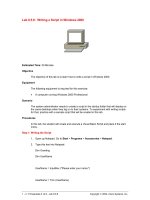Tài liệu Building a Spatial Database in PostgreSQL pptx
Bạn đang xem bản rút gọn của tài liệu. Xem và tải ngay bản đầy đủ của tài liệu tại đây (1.31 MB, 52 trang )
Building a Spatial Database
in PostgreSQL
David Blasby
Refractions Research
Introduction
• PostGIS is a spatial extension for
PostgreSQL
• PostGIS aims to be an “OpenGIS Simple
Features for SQL” compliant spatial
database
• I am the principal developer
Topics of Discussion
• Spatial data and spatial databases
• Adding spatial extensions to PostgreSQL
• OpenGIS and standards
Why PostGIS?
• There aren’t any good open source spatial
databases available
• commercial ones are very expensive
• Aren’t any open source spatial functions
• extremely difficult to properly code
• building block for any spatial project
• Enable information to be organized,
visualized, and analyzed like never before
What is a Spatial Database?
Database that:
• Stores spatial objects
• Manipulates spatial objects just like other
objects in the database
What is Spatial data?
• Data which describes either location or
shape
e.g.House or Fire Hydrant location
Roads, Rivers, Pipelines, Power lines
Forests, Parks, Municipalities, Lakes
What is Spatial data?
• In the abstract, reductionist view of the
computer, these entities are represented as
Points, Lines, and Polygons.
Roads are represented as Lines
Mail Boxes are represented as Points
Topic Three
Land Use Classifications are
represented as Polygons
Topic Three
Combination of all the previous data
Spatial Relationships
• Not just interested in location, also
interested in “Relationships” between
objects that are very hard to model outside
the spatial domain.
• The most common relationships are
• Proximity : distance
• Adjacency : “touching” and “connectivity”
• Containment : inside/overlapping
Spatial Relationships
Distance between a toxic waste dump and a piece
of property you were considering buying.
Spatial Relationships
Distance to various pubs
Spatial Relationships
Adjacency: All the lots which share an edge
Connectivity: Tributary relationships in river networks
Spatial Relationships
Containment: Rivers inside watersheds and land
(islands) inside lakes
Spatial Relationships
Stream side logging - adjacency and
containment.
Most Organizations have Spatial Data
• Geocodable addresses
• Customer location
• Store locations
• Transportation tracking
• Statistical/Demographic
• Cartography
• Epidemiology
• Crime patterns
• Weather Information
• Land holdings
• Natural resources
• City Planning
• Environmental planning
• Information Visualization
• Hazard detection
Why put spatial data in a RDBMS?
• Spatial data is usually related to other types
of data. Allows one to encode more
complex spatial relationships.
• Fire Hydrant: number of uses, service area, last
maintenance date.
• River: flow, temperature, fish presence, chemical
concentrations
• Forested Area: monetary value, types of trees, ownership
Historically?
• In early GIS implementations, spatial data and related
attribute information were stored separately. The attribute
information was in a database (or flat file), while the
spatial information was in a separate, proprietary, GIS file
structure.
For example, municipalities often would store property
line information in a GIS file and ownership information in
a database.
• Spatial databases were born when people started to treat
spatial information as first class database objects.
Advantages of Spatial Databases
Able to treat your spatial data like anything else in the DB
– transactions
– backups
– integrity checks
– less data redundancy
– fundamental organization and operations handled by the DB
– multi-user support
– security/access control
– locking
Offset complicated tasks to the DB server
– organization and indexing done for you
– do not have to re-implement operators
– do not have to re-implement functions
Significantly lowers the development time of client
applications
Advantages of Spatial Databases
Spatial querying using SQL
– use simple SQL expressions to determine spatial relationships
• distance
• adjacency
• containment
– use simple SQL expressions to perform spatial operations
• area
• length
• intersection
• union
• buffer
Original Polygons
Union Intersection









